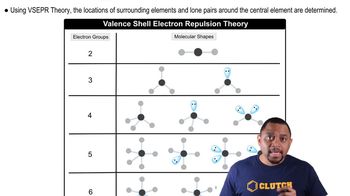Determine the molecular geometry about each interior atom and sketch each molecule. b. N2H2 (skeletal structure HNNH)
Ch.10 - Chemical Bonding II: Molecular Shapes & Valence Bond Theory
All textbooks Tro 4th Edition
Tro 4th Edition Ch.10 - Chemical Bonding II: Molecular Shapes & Valence Bond Theory
Ch.10 - Chemical Bonding II: Molecular Shapes & Valence Bond Theory Problem 45c
Problem 45c
 Tro 4th Edition
Tro 4th Edition Ch.10 - Chemical Bonding II: Molecular Shapes & Valence Bond Theory
Ch.10 - Chemical Bonding II: Molecular Shapes & Valence Bond Theory Problem 45c
Problem 45cChapter 10, Problem 45c
Determine the geometry about each interior atom in each molecule and sketch the molecule. (Skeletal structure is indicated in parentheses.) c. H2O2 (HOOH)
 Verified step by step guidance
Verified step by step guidance1
Identify the central atoms in the molecule H<sub>2</sub>O<sub>2</sub> (HOOH). In this case, the central atoms are the two oxygen atoms.
Determine the number of electron groups around each oxygen atom. Each oxygen atom in H<sub>2</sub>O<sub>2</sub> is bonded to one hydrogen and one other oxygen, and also has two lone pairs of electrons.
Apply the VSEPR (Valence Shell Electron Pair Repulsion) theory to predict the molecular geometry around each oxygen atom. With four electron groups (two bonding pairs and two lone pairs), the electron geometry is tetrahedral.
Considering the lone pairs, the molecular geometry around each oxygen atom in H<sub>2</sub>O<sub>2</sub> is bent or V-shaped.
Sketch the molecule showing the bent geometry around each oxygen atom, with an O-O bond linking the two oxygen atoms and each oxygen atom bonded to a hydrogen atom. The overall structure will appear as a 'skewed' H shape.

Verified Solution
Video duration:
5mWas this helpful?
Key Concepts
Here are the essential concepts you must grasp in order to answer the question correctly.
Molecular Geometry
Molecular geometry refers to the three-dimensional arrangement of atoms within a molecule. It is determined by the number of bonding pairs and lone pairs of electrons around the central atom, which influences the shape of the molecule. Common geometries include linear, trigonal planar, tetrahedral, and bent, each defined by specific bond angles.
Recommended video:
Guided course

Molecular Geometry with Two Electron Groups
VSEPR Theory
Valence Shell Electron Pair Repulsion (VSEPR) theory is a model used to predict the geometry of molecules based on the repulsion between electron pairs in the valence shell of the central atom. According to VSEPR, electron pairs will arrange themselves to minimize repulsion, leading to specific molecular shapes. This theory is essential for understanding the spatial arrangement of atoms in a molecule like H2O2.
Recommended video:
Guided course

Molecular Shapes and VSEPR
Skeletal Structure
A skeletal structure is a simplified representation of a molecule that shows the connectivity between atoms without depicting all the hydrogen atoms explicitly. In skeletal formulas, carbon atoms are often implied at the junctions and ends of lines, while other atoms are shown explicitly. This representation helps in visualizing the molecular structure and is particularly useful for complex molecules like hydrogen peroxide (HOOH).
Recommended video:
Guided course

Skeletal Formula
Related Practice
Textbook Question
751
views
Textbook Question
Determine the molecular geometry about each interior atom and sketch each molecule. c. N2H4 (skeletal structure H2NNH2)
874
views
Textbook Question
Each ball-and-stick model shows the electron and molecular geometry of a generic molecule. Explain what is wrong with each molecular geometry and provide the correct molecular geometry, given the number of lone pairs and bonding groups on the central atom. (c)
936
views
Textbook Question
Determine the geometry about each interior atom in each molecule and sketch the molecule. (Skeletal structure is indicated in parentheses.) c. NH2CO2H (H2NCOOH both O atoms attached to C)
1111
views
Textbook Question
Explain why CO2 and CCl4 are both nonpolar even though they contain polar bonds.
1610
views
Textbook Question
CH3F is a polar molecule, even though the tetrahedral geometry often leads to nonpolar molecules. Explain.
4481
views